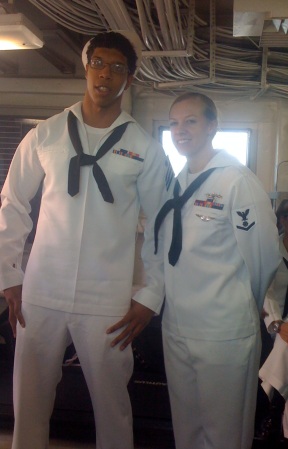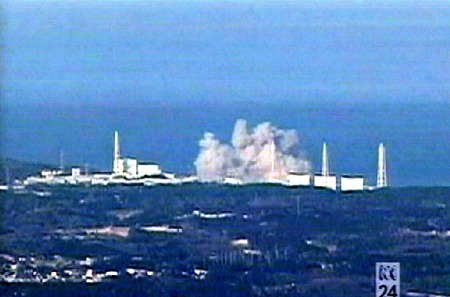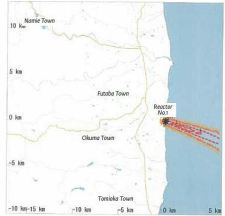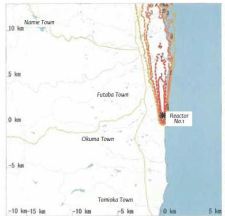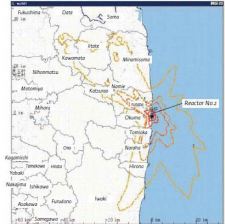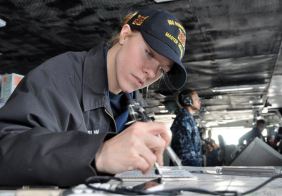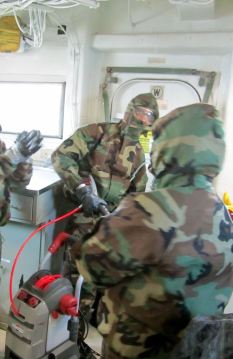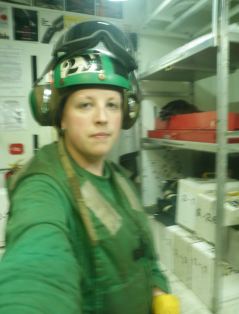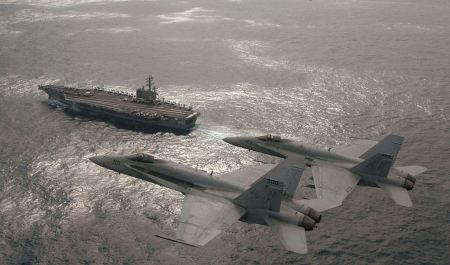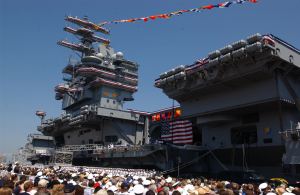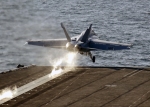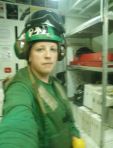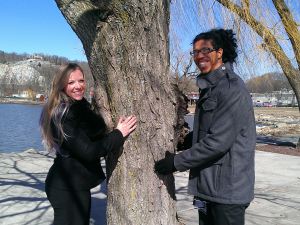2013年2月4日月曜日
福島救出作戦の永続的な遺産:パート1 米国海軍軍人の放射能汚染
A Lasting Legacy of the Fukushima Rescue Mission:
Part 1 Radioactive Contamination of American Sailors
by Roger Witherspoon
原子力空母ロナルド・レーガン
ロジャー・ウィザースプーン氏の2013年1月31日の記事、”A Lasting Legacy of the Fukushima Rescue Mission: Part 1 Radioactive Contamination of American Sailors ,“「福島救出作戦の永続的な遺産:パート1 米国海軍軍人の放射能汚染」を完全和訳しました。
元の英文記事
http://spoonsenergymatters.wordpress.com/2013/01/31/a-lasting-legacy-of-the-fukushima-rescue-mission-part-1-radioactive-contamination-of-american-sailors/
*****
米国防省は、日本において、破壊した福島第一原発から放出された放射性雲に捕えられた7万人弱の米軍人、軍属とその家族達の、前例のない医療登録を放棄する事にした。
登録の更新を止めるという事は、日本の63カ所の基地に駐屯している海兵隊、陸軍、空軍、工兵隊と海軍の軍人達、およびその家族に起こるであろう健康問題の 推移を観る手だてがなくなる、ということである。さらに、原子力空母ロナルド・レーガン第七艦隊の何千人もの水兵達や海兵達に放射能被ばくによる問題が出 ているのかを決定する際、彼らを見捨てる事になる。
第七艦隊は、南太平洋での任務から福島へ、トモダチ作戦のために派遣された。トモダチ作戦は、日本の東北沿岸部を破壊して2万人以上の死者を出した地震と大 津波に対する、80日間の人道支援と救出作戦だった。この救出作戦は、日本政府に要請され、米国務省、原子力規制委員会、国防省とエネルギー省によって コーディネイトされた。5500人の乗組員を持つ原子力空母ロナルド・レーガン以外に、打撃群は、ミサイル駆逐艦4隻(プレブル、マクキャンベル、カー ティス・ウィルバーとマケイン)と巡洋艦チャンセラーズビル、そしてその他の応援艦で構成された。
これまでに、救出作戦に参加した150人以上の男女の軍人に、放射能被ばくによって引き起こされたと思われる、腫瘍、振戦、内出血や脱毛などの様々な健康被 害が起こっている。彼らはこの状況について海軍を責めていないが、東電が福島原発から出ている放射能汚染の拡散状況について米国政府に嘘の情報を提供した と言う理由で、東電に対する訴訟に加わりつつある。そして、国防省がトモダチ登録を放棄すると言う事は、彼らが医療的な援助を受けられないという事にな る。
航空母艦レーガンの航海科士官の2人である、海軍クォーターマスターのモウリス・イニスとジェイミー・プリムは、海上での仕事は区分されているのだと説明し た。艦内で、危険な放射能プルームが風で飛ばされて来ていると知っている人は少なく、海流が汚染させているかもしれないとは、誰も知らなかった。警報機が 鳴った時、問題が起こったのだと分かった。
「我々は、艦内の塩分除去装置を用いて飲料水を作ります。」と、フロリダ州セント・オーガスティン市出身の28歳であるプリムは言った。「その水は海から来ま す。そして、海が放射能汚染されていました。そのため、艦内の水を一旦全部捨て、汚染がなくなるまで、装置を何度も洗って汚染が残っていないのを検査する 必要がありました。
艦内には冷却水を必要とする原子力発電所がありますが、その原子炉を、福島原発の原子炉からの放射能で汚染するわけにはいきませんでした。」
原子力空母ロナルド・レーガンの位置を海図に記入する航海科士官ジェイミー・プリム
しかし、放射能汚染を避けるのは簡単ではなかった。海流が汚染されていない沖まで移動し、船やパイプを洗い、再び岸へ戻った。
「我々は、海図上のどの場所に放射能があるのかを目視することができたわけですが、そこを航海するのは緊張しました。」とイニスは語った。「一般の人々、およ び、民間の船は、放射能がどこにあるのか、あるいは、それが何か分からず、口コミや噂に頼っていました。我々はもっと多くの情報を持っていました。しか し、東 電から心配しなくていい、と言われていたがために、どれくらいの放射能が放出したのか、知る手だては完全に閉ざされていました。
航海科士官モウリス・イニス
我々は延べ80日、沿岸から2マイル(3.2km)まで近づき、そして、移動しました。風向きに左右されるイタチごっこでした。助けが必要な日本の人達を援助 するために戻り続けましたが、その度、また別の危険な場所に到達しました。最初に警報が鳴った後は、東電がないと言った場所に放射能汚染があり、その度に 全てを遮蔽し、ガスマスクを持ち歩かなければいけませんでした。」
放射能に関して的確な情報を得る事に関しては、陸に居た米国人達も途方に暮れていた。当時の米国原子力規制委員会(NRC)委員長であったグレゴリー・ヤッ コは、爆発した原子炉から50マイル(80km)以内に居住する米国人の避難を促した。国防省は、放射能探知機が環境放射能の上昇を察知した後、福島から 南へ300マイル(480km)にある横須賀海軍基地から、女性と子供を避難させた。
情報収集は困難であり、日本の官僚制の融通のきかなさがために、その困難は、さらなる困難さを招いた。『憂慮する科学者同盟』の原子力専門家の2人であるデ イヴィッド・ロックボウム(NRCと原子力産業の元コンサルタント)とエド・ライマン(核物理学者)は、データベースが一時間毎に変わって具体的な情報を 得るのが難しかった混乱期の間の、何千もの政府メールや外電などの調査をした。
「福島第一原発4号機の爆発後、日本側は使用済み燃料プールの冷却に十分な水を投入する事ができませんでした。」とロックボウムは言った。「なので、米政府は わざわざオーストラリアから、コンクリートポンプトラックを本州北部の米海軍基地へ空輸しました。なのに日本政府は日本の道路を移動する許可証がないと 言って、基地から動かす事を許しませんでした。彼らに起こっていた問題の規模を考慮すると、その優先順位は間違っていると思えました。
しかし日本文化は、皆が指揮者の指示に従うシンフォニーのようなものです。一方、アメリカ社会は、皆が一緒に演奏していても即興が高く評価される、ジャズ・アンサンブルのようなものなのです。」
日本側から、まとまった、かつ、信用に値する情報を得られない状況は、アメリカの救助活動の妨げとなった。
福島から約300km(注:原文では60マイル、すなわち96kmと書かれているが、実際には300km位)に位置する厚木基地がベースの、ヘリコプター戦 隊の上級一等整備士マイケル・シーボーンの回想によると、「地震と津波の後に、我々の戦隊は、一日の猶予を持って、司令部の荷造りをし、仙台と福島地域に 援助活動をするために三沢空軍基地に移動するように言われました。他の戦隊は全部グアムに避難していました。厚木基地が閉鎖されてしまい、もう戻れないで あろうと言う、大きな可能性がありました。もう戻れないだろうから、と自分の車のダッシュボードに名前と電話番号を記すように言われました。
三沢基地には3週間半居て、人を救助したり物資を運んだり、毎日継続した往復飛行の任務をこなしました。原子力技術者が何人か居て、任務から戻って来る人達 のスクリーニングをしました。軍服の一部分を切ってしまわなければいけないことが多くありました。(注:恐らく軍服の一部分が放射能汚染されていたためと 思われる)」
シーボーンは、グアムに3日派遣され、集中トレーニングを受けて放射能士官に任命された。それは簡単ではなかった。
放射能士官マイケル・シーボーン
「これは完全に未曾有の出来事でした。我々は、以前に放射能と対処した事はありませんでした。全てが新しい事で、皆、訳が分かっていませんでした。我々は、化 学兵器と生物兵器を用いた演習は十分受けていましたが、放射能を扱った演習は受けた事がありませんでした。これは核の事ですが、我々は核に関しては扱わな かったのです。空軍の連中は、放射能と対処した事がありませんでした。航空機が放射能汚染を受けた事はありませんでした。だから、我々は、全く盲目的に飛 んでいたのです。」
シーボーンのグループの整備士達にはルールがあった。帰還したヘリコプターに放射能スクリーニングをした。そして、汚染された部品を外して水を張った特別の容 器に入れ、滑走路の離れた場所に隔離した。三沢で雪が降り始めたので、福島に近い厚木基地に戻った。シーボーンは、電動放射能探知機で、変動する放射能レ ベルを、Corrected Counts Per Minute(CCPM)と言う単位で測った。(注:CCPMとは、CPMで測定された実測値からバックグラウンド値を差し引いた数値である)
「普通の外での自然放射線量は5から10 CCPMです。」とシーボーンは言った。「そして、それは太陽から来る放射線です。厚木基地でのバックグラウンド放射線量は、大気で200から300 CCPMありました。放射能はそこら中にありました。水が放射能で汚染されていました。地面が放射能で汚染されていました。空気が放射能で汚染されていま した。
ルールはこうでした。何かから500 CCPM以上の測定値が出たら、特別の手袋が必要でした。1000 CCPM以上なら、タイベックス放射能スーツが必要でした。5000 CCPM以上なら、スーツ、フィルター付き保護マスク、ゴーグルと二重手袋の一式が必要でした。汚染されたラジエーターはヘリコプターに戻すことはできな く、取り替えなければいけませんでした。ラジエーターを外して測定した時に、60,000 CCPMだった事があるのを覚えています。」
しかし、最終的に、安全設備は十分でなかったかもしれない。
作成に2年かかり、2012年末に完成したトモダチ医療登録は、米国上院退役軍人問題委員会の委員長であるバーモント州のバーニー・サンダース上院議員の主張に基づいて始まった、国防省、エネルギー省と 退役軍人委員会の共同活動であった。
トモダチ医療登録は、福島第一原発の1号機から4号機より何ヶ月も大気と海に放出された放射能、特にヨウ素とセシウム、への被ばくによる長期的影響があるかと言う事を決めるための医学的ベースラインを作るために不可欠な、徹底した登録制度であった。
https://registry.csd.disa.mil/registryWeb/Registry/OperationTomodachi/DisplayAbout.do
トモダチ医療登録の深さは他に例を見なかった。国防省の、252ページに渡る、7万人の米国人の放射能被ばく量評価は、福島からの距離、仕事の種類と呼吸数 への影響、天候の変動、性別、体のサイズや年齢等の色んな因子によって分類されている。子供は、年齢による放射能への感受性を反映して、6つの年齢グルー プに分類された。
さらに、この報告では「8000人以上が内部被ばく検査を受け、その結果が計算された被ばく量と比較された。」と述べられている。
しかし最終的に国防省は、全身と甲状腺においての最大で可能な推定被ばく量が、さらなる調査を必要とするほどひどくなかったと言う結論に達した。
海軍のスポークスマンであるマシュー・アレン大尉の声明書には次のように述べられている。「国防省は、この推定被ばく量の正確さについて非常に高い信頼を 持っています。なぜかと申しますと、この推定被ばく量は、大変保守的な被ばく状況(例えば、環境放射線量が高く、呼吸数が普通よりも多い60日間ずっと、 24時間外に居たと仮定)を仮定した結果であるからです。
この推定被ばく量は、退役軍人の線量再構成に関する勧告委員会(VBDR)と米国放射線防護・測定審議会(NCRP)によって綿密に検討され、推定被ばく量 の計算方法が適切であり、結果が正確であるという評価を受けました。さらに、線量推定は、日本政府やWHOの推定と一致していました。」
国防省のスポークスウーマンであるシンシア・スミスは、国防省が重篤な放射能汚染がなかったと決定したため、「2011年3月11日位から始まった福島第一 原発の事故とそれに続く放射能の放出後に日本の本州とその近辺にいた国防省関連の集団の中の誰においても、健康調査対策は必要でありません。」と付け加え た。
しかし、環境を汚染した放射能レベルが低かったから、日本で生活していた大人や子供の継続したモニタリングが必要でないという、国防省の総括的な結論に懐疑的な意見もある。
議会で証言するデイヴィッド・ロックボウム
ロックボウムは、「放射能は均一的に拡散しません。」 と言う。「ホットスポットとロースポットがあり、誰が高いゾーンに居て誰が低いゾーンに居るのかは、誰にも分かりません。実際の個人の放射能被ばく量が、 誰に分かると言うのでしょうか?飲食からの被ばく量は(推定の)計算に入れられませんでした。
これは海軍が行った、数少ないデータポイントをグループ全体に照らし合わせるという、全力の試みです。多数の測定が行なわれましたが、これらは時間の中のひとつのポ イントに過ぎません。夜景をストロボライトで撮影するのに似ています。ストロボがつく度に、場所の一部分の写真を撮る事になります。でもそれで、暗闇の全 てをとらえたと言えますか?」
http://fukushimavoice.blogspot.jp/2013/02/1.html
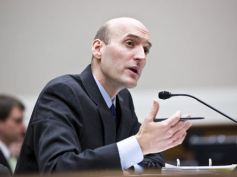 Transcripts of meetings and conference calls hosted by Nuclear Regulatory Commission Chairman Gregory Jaczko showed steadily increasing concern as newer data contradicted previous data and measurements of radiation from the Navy differed markedly from the information coming from the Japanese government and TEPCO, the giant utility which owned the stricken reactors. ( NRC’s Operation Center Fukushima Transcript )
Transcripts of meetings and conference calls hosted by Nuclear Regulatory Commission Chairman Gregory Jaczko showed steadily increasing concern as newer data contradicted previous data and measurements of radiation from the Navy differed markedly from the information coming from the Japanese government and TEPCO, the giant utility which owned the stricken reactors. ( NRC’s Operation Center Fukushima Transcript )
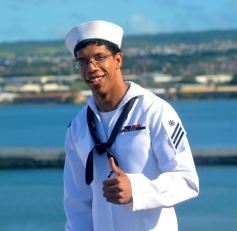 “My coach was an ex-Marine who had traveled the world, competing for the military. It sounded like a great life and I wanted to compete for the Navy, too. When I was 19, we went down to the recruiting station and talked about the opportunities they had, and I enlisted. It was 2007, but there was a lot of crying at home because my Mom was afraid I would get hurt because of the war and 9/11. But I told her that this is what I want to do with my life.
“My coach was an ex-Marine who had traveled the world, competing for the military. It sounded like a great life and I wanted to compete for the Navy, too. When I was 19, we went down to the recruiting station and talked about the opportunities they had, and I enlisted. It was 2007, but there was a lot of crying at home because my Mom was afraid I would get hurt because of the war and 9/11. But I told her that this is what I want to do with my life.
 “I had no faith in the Registry to begin with,” said Arnie Gundersen, a nuclear engineer and specialist in the spread of radiation in the environment. “With the atomic bomb survivors from the military program in the Utah desert, the registry that the Defense Department put together was bogus. The exposure they got was much greater than the Defense Department calculated.
“I had no faith in the Registry to begin with,” said Arnie Gundersen, a nuclear engineer and specialist in the spread of radiation in the environment. “With the atomic bomb survivors from the military program in the Utah desert, the registry that the Defense Department put together was bogus. The exposure they got was much greater than the Defense Department calculated.
 Michael Sebourn had seen a lot of parts wear out during 17 years as a naval aircraft mechanic. Many of the helicopters he serviced at Atsugi saw heavy use and parts were replaced to ensure safety and maximum performance. But during Operation Tomodachi helicopter parts – particularly the radiators and air ducts – were replaced after just about every flight because of the huge amounts of radioactive particles they sucked into the engine.
Michael Sebourn had seen a lot of parts wear out during 17 years as a naval aircraft mechanic. Many of the helicopters he serviced at Atsugi saw heavy use and parts were replaced to ensure safety and maximum performance. But during Operation Tomodachi helicopter parts – particularly the radiators and air ducts – were replaced after just about every flight because of the huge amounts of radioactive particles they sucked into the engine.
By Roger Witherspoon
To the US Government, Operation Tomodachi was just another big humanitarian aid and rescue mission in which the nearest Navy fleet and many land-based personnel rushed to the aid of an ally in need. In this case, the northeast coast of Japan had been flattened by a massive earthquake and tsunami which destroyed infrastructure and killed some 20,000 citizens.
Operation Tomodachi – named after the Japanese word for Friend – began as a large logistical exercise. It seemed that way to the American sailors, both land based and in the USS Ronald Reagan Aircraft Carrier Strike Group. The view from Washington was that Operation Tomodachi would enhance the long ties between allies.
Then everything changed.
The nuclear fuel in reactors 1,2, and 3 at Fukushima Daiichi overheated and melted down, creating a hydrogen cloud in the process which exploded, spiking radiation readings on detection monitors across Japan. Hydrogen from Unit 3 migrated through a shared venting system into Unit 4 and blew off its roof as well, exposing the spent fuel pool and its 1,500 bundles of fuel rods containing a lethal mix of cesium, iodine and plutonium.
 Transcripts of meetings and conference calls hosted by Nuclear Regulatory Commission Chairman Gregory Jaczko showed steadily increasing concern as newer data contradicted previous data and measurements of radiation from the Navy differed markedly from the information coming from the Japanese government and TEPCO, the giant utility which owned the stricken reactors. ( NRC’s Operation Center Fukushima Transcript )
Transcripts of meetings and conference calls hosted by Nuclear Regulatory Commission Chairman Gregory Jaczko showed steadily increasing concern as newer data contradicted previous data and measurements of radiation from the Navy differed markedly from the information coming from the Japanese government and TEPCO, the giant utility which owned the stricken reactors. ( NRC’s Operation Center Fukushima Transcript )
The NRC itself was flying blind. The agency had believed it was virtually impossible to have multiple meltdowns at the same site. As a result, their emergency models all involved the healthy plant using its working systems to control critical systems in the stricken plant until the problems were solved. Jaczko had publicly urged calm and for Americans in Japan to follow the guidelines of the Japanese government. NRC press releases in the United States all stated prominently that there was no danger from radioactive fallout.
But the transcripts tell another story.
On March 14 Jaczko’s conference call was interrupted by Jack Grobe, Deputy Director for Engineering in the Office of Nuclear Reactor Regulation, with bad news:
“JACK GROBE: Okay, guys, I apologize for bothering you, but things are degenerating quickly. This reminds me of the drill. [...]
what’s really troubling is that we, we have had that wind shift — the Chairman’s here, by the way — we’ve had that wind shift and the wind is out of the northeast blowing towards the southwest. That’s inland and towards Tokyo. And there’s an aircraft carrier in the port just south of Tokyo. It’s about 180 miles from the site, about 10 miles southwest of Tokyo, and they’re measuring on the order of 10 to 20 millirem over a 12-hour period total effective dose and roughly five to 10 times that, thyroid. [...]
JACK GROBE: The, the answer is the dose rates don’t seem to be consistent either with what would be released or with the timing that it would take for a plume to get 180 miles away from the site to the southwest.
MIKE WEBER: Yeah, well, that’s what I struck me when you told us what’s going on.
JACK GROBE: Yet, but the, the feedback through Trapp from the admiral is that they used multi* instruments and confirmed this in multiple ways [BLACKED OUT]
MIKE WEBER: Wow.
JACK GROBE: They do operate nuclear-powered aircraft carriers, so they must have a level of competence that’s fairly decent. [...]”
This was new territory, and they could not trust data from the Japanese.
For the Americans in Operation Tomodachi, this meant they would be improvising throughout the crisis. They faced the dual needs to conduct search and rescue missions in a devastated landscape with little functioning infrastructure while guarding against unseen contamination from the stricken reactors.
To officials at the Defense and State Departments, and Nuclear Regulatory Commission, Operation Tomodachi was a successful, limited duration event in which the military worked in a civilian humanitarian mission. It was requested, logged, and finished.
But military operations are carried out in real time by people implementing orders from half a world away who have to live with the consequences of making the mission succeed.
And for some of the Americans sent into action, Operation Tomodachi would mean the end of a career and dream of service in the US Navy, and the start of a new life laced with anxiety.
The Junkie’s Kid
Michael Sebourn was just another kid nobody wanted, from a neighborhood nobody cared about, with a future leading towards jail or death and a life nobody would have missed. Then he met the US Navy.
“My mother was a drug addict and my father was killed when I was 18 months old trying to rob a drug dealer,” he said. “We lived in the housing projects in Charleston, South Carolina. My stepfather was abusive and spent all the money my mother made on drugs and alcohol. I was malnourished and underweight.”
At age five he was sent to live with his grandparents, who died two years later. He moved in with an aunt in Gary, Indiana, a poor white kid in a predominantly poor, black part of a decaying city.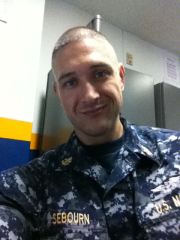

“I never thought I would ever be able to accomplish anything,” Sebourn said. “I knew college was out of the question because I was poor. I worked in a factory for a while after high school, but that didn’t work out and I was homeless for three months, living out of a truck and driving to Wal-Mart parking lots to sleep.”
He moved back in with his aunt. He had a bad attitude, made bad choices, and “had a couple of run-ins with the law. I needed something new. I had nothing going for myself at all and I wanted a fresh start. I asked my aunt if I should join the military and she ran into the kitchen and got her car keys and said ‘let’s go’. Two days later I was gone.”
He did well in the Navy’s Great Lakes training station and when he was offered a choice of assignments, it turned out to be administrative. “Something clicked,” he said of his entry into the Navy in 1993. “I got my pride back. I got a sense of worth and I started succeeding. I decided serving in the Navy was something I needed to do.
“It was the first time I felt I had a home. It was the first time I felt I had a family.”
It would not be his only family.
He landed in Japan 17 years ago, loved it and stayed at the Navy’s Misawa naval air base, working his way up to head mechanic for the helicopter squadrons based there. He married a Japanese woman and, eventually they had a son. He was half a world and a full life away from the drug dens of South Carolina. He was a Navy man.
The Athlete and the Musician
Maurice Enis was a tall, strapping kid from the frost belt of Rochester, Minnesota whose world revolved around sports and physical fitness. “I was running track at Century High School in Rochester,” he recalled, “doing the 400 and 200 meters and wanted to continue.
 “My coach was an ex-Marine who had traveled the world, competing for the military. It sounded like a great life and I wanted to compete for the Navy, too. When I was 19, we went down to the recruiting station and talked about the opportunities they had, and I enlisted. It was 2007, but there was a lot of crying at home because my Mom was afraid I would get hurt because of the war and 9/11. But I told her that this is what I want to do with my life.
“My coach was an ex-Marine who had traveled the world, competing for the military. It sounded like a great life and I wanted to compete for the Navy, too. When I was 19, we went down to the recruiting station and talked about the opportunities they had, and I enlisted. It was 2007, but there was a lot of crying at home because my Mom was afraid I would get hurt because of the war and 9/11. But I told her that this is what I want to do with my life.
“And it was good. It saved me, in a way. I was aimless and it taught me a lot more about my time and what you can do and accomplish. Being deployed, you have no time to do anything extra. Every minute of the day is accounted for. When you get out and have 24 hours to play with, I can accomplish so much more now because I can manage my time and I learned how to prioritize.
“I really did grow up in the Navy. They didn’t have track and field in the Navy anymore, so I chose navigation and general quartermaster. There is the old school way, navigation using different celestial bodies, and the new way, which is all math and computers. You learn to use all the different navigation systems that we have. You apply it to the paper nautical charts and use the satellites and you can actually figure out exactly where we are in the water.”
He also fell in love.
Jaime Plym came from as far away from the snow as one can get without swimming in the Caribbean, which she also enjoyed. She grew up in St. Augustine, Florida, one of the nation’s oldest cities and went on to attend Jacksonville University for two years as a music major, playing bass clarinet.
I decided I wanted music in my life,” Plym said, “but I didn’t want it as my job. I quit school and just worked as a pre-school teacher in Gainesville. I wanted to go back to school, but I had been on a music scholarship and I didn’t have the money for any other major.”
She felt aimless, and went home and loafed on the beach as 2007 drew to a close. She had a brother who was in the Marines and decided she, too, could join the service. “But I wanted to be out to sea,” she said. “I wanted to be on a big ship.”
Plym and Enis were in the same class at the Great Lakes training center and came together at the end. “I was trying to figure out what I wanted to do,” she said. “They told me about quartermaster, which meant we worked at the command center and were responsible for navigation. I signed up for it.”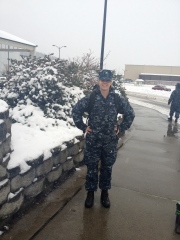

Navigation is critical, especially on an aircraft carrier. Other naval craft can move and shift to be in the most favorable position regarding the wind and the currents, with their navigators finding the best and quickest routes to take. That is especially important if there is danger approaching, like a slow moving radioactive cloud.
Navigators on an aircraft carrier do not have that luxury. Their quarter-mile deck slowly rolls side to side, and up and down in accordance with the sea. They must find the smoothest spot and hold it for the duration of the mission, regardless of what comes. After the aircraft leave the deck, the ship must remain at that spot so they can find their way back.
That makes dodging dangerous winds and radioactive currents problematic.
But they didn’t know that when they graduated from the training camp and began life as quartermasters and navigators on the USS Ronald Reagan, head of a carrier battle group plying the South Pacific.
“We had a lot of fun,” said Plym. “We were friends at first, and then we started dating.”
On March 11, 2011, the USS Ronald Reagan and Carrier Strike Group 7 were headed for port in South Korea as a tsunami struck the northeastern coast of Japan.
“We knew right away they were going to redirect us to go to Japan and provide aid,” Plym said. “We were there by 5 AM the next morning.
“We didn’t know about the reactors,” said Enis. “We didn’t have outside contact like the internet or cable to know what was going on on land. We just knew there was a major crisis. We had no idea about the nuclear plants till they notified the captain of a possible radiation scare. That’s when we found out that there might be a possible radiation leak.
Something New: Radiation
Operation Tomodachi began with the request for help from the Japanese Embassy to Kurt Campbell, assistant secretary of state for East Asian and Pacific affairs who quickly turned to Gregory Jaczko, then chairman of the US Nuclear Regulatory Commission, and Admiral Mike Mullen, Chairman of the Joint Chiefs of Staff who would regularly brief President Barak Obama on the escalating difficulties on land.
What had begun as a rescue mission was being increasingly complicated by spreading radiation from Unit 1 at the six-reactor, Fukushima-Daiichi nuclear complex. At least three other reactors were in danger of failing, including the spent fuel pool of reactor Unit 4, holding 1,535 bundles of irradiated fuel.
On March 12, as the USS Ronald Reagan and Carrier Strike Group 7 arrive two miles off the coast, Fukushima Unit 1 blows up. Unit 3 will explode March 14, and the hydrogen gasses migrating through a shared vent will also destroy the containment building at Unit 4, exposing the spent fuel pool to the air. Unit 2 will explode March 15. Tokyo Electric Power Company (TEPCO) will announce that most of the fuel in Units 1,2, and 3 are intact. They are not. They have fused into a molten mass and are oozing through the bottom of their destroyed reactors.
The Japanese government, not wanting to acknowledge that the situation was getting out of control, did not activate its military, the Special Defense Forces, to airlift water to the stricken Unit 4 and continuously drop it on the spent fuel to keep it from exploding in a nuclear fuel fire. According to Asahi Shimbun, a leading Japanese newspaper which obtained the communications between Tokyo and Japan’s embassy in Washington, Mullen sent a cable to Ichiro Fujisaki, Japan’s ambassador to the US, stating that the SDF should be used to cool the reactors:
“The U.S. military believes the No. 4 reactor is in danger. It feels every step should be taken to cool the reactor, including using the SDF,” the cable said. “The United States has made various preparations to deal with the nuclear accident. The president is also very concerned…” ( http://bit.ly/WS7rXG )
At the Nuclear Regulatory Commission, Jack Grobe is leading a crisis team in the 24-hour Operations Center in nearly constant conference calls with Jaczko and a team in Japan. Their previous scenarios – including the long held belief that it was impossible to have multiple meltdowns in a single nuclear complex, and that the containment structure would stop radiation from spreading from a reactor to the environment – have proved explosively wrong and their scenarios for keeping people safe from spreading radiation are being called into question.
The NRC’s redacted transcript of those conversations shows that after the explosion at Unit 4 Grobe says in exasperation “The projections on releases with the containment intact are completely insignificant now.
“I mean, this is beginning to feel like an emergency drill where everything goes wrong and you can’t, you know, you can’t imagine how these things, all of them, can go wrong.”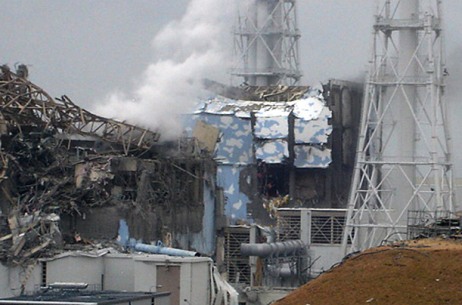

But the NRC released several daily press releases, all reassuring the public that there was no danger to the public.
And on the high seas and at the American naval installations, the sailors of Operation Tomodachi were on their own.
–Winifred Bird contributed reporting from Japan
By Roger Witherspoon
For several days, the winds from the destroyed nuclear reactors at Fukushima Daiichi crashed head on into the myth of the radioactive plume.
It is the most enduring falsehood of commercial nuclear power, promoted heavily by both the industry and its watchdog, the Nuclear Regulatory Commission. It is a myth with two conflicting premises:
- Radioactive gasses spewing from a stricken reactor or spent fuel pool have an inherent property which holds them in a tight, thin stream which prevents widespread contamination.
- At 10 miles the plume disperses like steam from a teapot, leaving traces that are either too small to measure or are so minute as to be “below regulatory concern.”
The contradiction between being tightly bound and widely dispersed is never challenged. It was most clearly enunciated at a public hearing April 8, 2002, in White Plains, New York, on the evacuation plans for the two Indian Point reactors, located about 30 miles north of Manhattan, owned by Entergy Corp. There was no dissent from NRC officials as Entergy’s Larry Gottlieb said, glibly, “the easiest way to avoid a radioactive plume is to cross the street.
“It’s kind of like someone pointing a gun at you and all you have to do is step to the left or right to get out of the pathway of the bullet. That’s all you have to do.”
During the frenetic first week after the March 11, 2011 earthquake and tsunami destroyed the infrastructure of Japan’s northeast coast, killed some 20,000 people, and set four of the six Fukushima Daiichi reactors on an irrevocable path to meltdowns, officials from the U.S. Departments of Defense, State, and Energy, as well as the Nuclear Regulatory Commission clung to the notion that the situation was manageable as long as the “plume” held true to the myth and blew out to sea.
That was paramount to DoD, which had 63 military installations throughout the Japanese islands containing some 60,000 men and women and their families. It was a relief, therefor, when the aircraft carrier, the USS Ronald Reagan reported March 13 that its sensors were picking up radioactive material on its flight deck, 130 miles off the coast.
According to the NRC Status Report, “The measureable radioactivity was consistent with the venting of the Fukushima Daiichi Unit 1 reactor. The Navy also collected air samples having activity above background from the ‘plume’. Analysis, the report states, would show the Reagan contaminated with “iodine, cesium and technetium, consistent with a release from a nuclear reactor.”
And that was good, because the plant operator, TEPCO, maintained that the reactors were under control and radiation stemmed from planned venting of built-up gasses, not from a complete meltdown. As long as the radiation was staying in a plume blowing out to sea, there would be no need to evacuate all the American bases, or the millions of residents in the Tokyo metropolitan area.
In reality, Fukushma Unit 1 began to meltdown as a result of the earthquake, before the tsunami hit and destroyed all backup power. The molten core of the reactor would melt through the reactor vessel and containment, crashing into the water below the reactor and sending radioactive steam surging out of the damaged building. Monitoring stations, which were not analyzed till January, 2013, found radiation rose more than 700 times the background levels at least an hour before the venting. Officials assumed the Reagan detected a controlled plume which, in fact, had not yet been created. Instead, the ships were in a radioactive cloud which had not been anticipated.
What TEPCO did not say – and what American officials overlooked in that hectic period – was the fact that the venting did not work.
“The difference between Chernobyl and Fukushima,” said nuclear safety engineer Arnie Gundersen, “was that the fire at Chernobyl sent the radiation high into the atmosphere and it was widely dispersed. There was no fire at Fukushima. You had those beautiful venting towers, but the vents were inoperable because there was no power to activate the industrial fans.
“So the radioactive steam just rolled out and over the countryside like ground smog. About 80% of it blew out to sea.”
And the discrete plume was a myth. The Reagan and its attendant warships constantly attempted to dodge a solid plume when, in reality, there was a spreading cloud continually overhead and increasing amounts of contaminated currents all around them.
By March 16, after explosions had destroyed the buildings housing Fukushima Units 1-4, Kurt Campbell, Assistant Secretary of State for East Asian Affairs, officials at the NRC and DoD were increasingly upset with the Japanese government for relying on TEPCO for information rather than taking charge.
Asahi Shimbun, the Japanese newspaper, reported that an internal report on the issue sent to Campbell and “secretly circulated among top State Department officials on that day contained one word – ‘FUBAR’—or Fu**ed Up Beyond All Recognition.” ( http://bit.ly/Wb87Lc ). Among those receiving the report was Secretary of State Hillary Clinton.
The NRC was also focused on preventing contamination on land. They were baffled when radiation was detected at the Yokosuka naval base 180 miles south of Fukushima, because all of their models were designed to show the radioactive “plume” going out to sea. What was lost in the concern over the millions of Japanese and thousands of Americans on land was the impact of the radiation going out to sea, where the USS Reagan’s strike group was providing search and rescue assistance under Operation Tomodachi.
In the midst of a disaster, that oversight was understandable. “I would have been in the same camp,” said David Lochbaum, nuclear safety engineer with the Union of Concerned Scientists. “I would have known there were people on land and, vaguely, out to sea. But given the choice of which way the wind was blowing, I would have had a sigh of relief that it was blowing offshore.
“Somewhere the light should have gone off that there was a Navy out there. But it didn’t.”
And the sailors of Operation Tomodachi were on their own.
The Nuclear Guessing Game Begins
In the military, information is amassed at the top, and then parsed out in pieces on a need to know basis. As the crisis developed off the coast of Fukushima, it was decided that most navy personnel needed to know very little. That stratification of knowledge was evident on the USS Ronald Reagan aircraft carrier, and accompanying Strike Group 7 was deployed to conduct search and rescue operations along the stricken Japanese coast. The navigators had to be given enough information to work with.
“We knew there was a leak of radiation on land,” said navigator Jaime Plym, “and common sense meant it would be close to shore. Most of the time our ship was about two miles from shore because our helicopters were going back and forth.”
“In our position as navigators,” added Maurice Enis, “they let us know more about what was going on. But they didn’t want to cause a panic and get the crew scared. So they didn’t put out much information about the radiation leak.
“But we had to plot it on the charts, and guess what the danger zones were, and how far the plume clouds were going to travel. We didn’t know for sure, but we had sensors going off in the Pilot House on the bridge, and the actual helo guys they were sending out were doing testing of the air. “
In an effort to dodge a radioactive “plume” the admirals and captains in the carrier strike force ordered the navigators to plot the exact location of the Fukushima Daiichi plants. Then they plotted a nautical “T” from the plant site, by drawing a line 50 miles straight out to sea, and then crossing it with a line stretching 25 miles north and south of that spot. Lines from the end of the T back to the nuclear plant formed a triangle which the Navy assumed contained and confined the radioactive plume.
“They were just guessing,” said Plym. “We were supposed to avoid the triangle, but there were times where we had to go through the plume to deliver supplies to the Japanese, and aid and food and water. We just couldn’t or didn’t have the time to go all the way out and around the triangle and come back on another side.
“When we pulled into shore to give them supplies it was pretty much in the plume area. We were only two miles off the coast and even if we were outside the triangle that they had us draw, we did pass through the triangle.”
But the triangle wasn’t their only problem. Frequently, helicopter or jet pilots would return with data showing radiation in the area, and the ship would take a detour from the unseen menace.
“We stayed offshore about 80 days,” said Enis, “and the way it worked was we would stay close to shore and then sail away. It was a cat and mouse game, depending on which way the wind was blowing. We were never sure where it was. Then came the first scare, and we found there was radiation when the Japanese had told us there was none. So we went on lockdown and had to carry around gas masks.”
Yet the lack of concrete information and the lack of trust in the Japanese led to a ship full of rumors and fears. Transcripts of conference calls centered in the Nuclear Regulatory Commission’s Emergency Operations Center reveal that the captain of the Reagan was ordered to take hourly readings of radiation and send them to the American Embassy for processing. The ship was contaminated with cesium, iodine, and technetium, all products of nuclear reactors. The Defense Department did not want to rely on information from the Japanese government or TEPCO. Navigators like Enis and Plym were given some information from the data collected bythe pilots.
“We could actually see certain parts of the sea chart where radiation was actually found,” said Enis. “And to try and navigate through that was nerve wracking. There was no absolute way for us to know how much radiation was out there, though, because we were still being told by the power company that we shouldn’t worry.
“For the rest of the ship, who didn’t even know what we knew, there was just word of mouth and rumors.”
When the helicopters and jets returned from their missions they were met by personnel in radiological suits who would scrub the craft down with soap and water. They never knew if it was useful.
“I was aggravated the whole time,” said Plym. “It doesn’t matter what is happening, because it’s not like you can say ‘Forget this! I’m going home!’ So you turn into a zombie and say OK, I’m going to wash now and it will be all right. But we were scared the whole time we were over there.
“None of us knew anything about radiation. We were thinking we’re going to grow extra arms! It was funny. We talked about those that used to make the digital watches, and how they all died of cancer and wondered if that would be us. We didn’t really know. We went back and forth between freaking out and ignoring it.”
In a sense, the military discipline helped the sailors work through their fear.
“You get an order and you follow it,” said Enis. If they tell us to spray the ship to clean it, we do that and think we’re cleaning it. But if someone at the top was given wrong information about cleaning radiation from the ship, then we were pretty much going in circles.
“So you think of the greater good that you’re doing – especially when you see entire houses floating by the ship and wonder if there is a family dead inside. And you think about the small children on land and how happy they are when the helos come to give them food. You focus on that more than on your own self or your own fears.”
Mechanics and Hot Engines
There were no windows below decks on the Reagan, where Jennifer Micke and her crew worked to keep the F-18 jets in top condition. The Reagan, with a crew of 5,500, was five times larger than Thorp, Wisconsin, the little farming community where Micke grew up on a dairy farm down the road from her grandparent’s farm. It had been expected that, one day, she’d have a farm of her own a bit further down the road.
“We went on a family trip to the Osh Kosh Airplane Museum when I was in high school,” said the 22-year-old jet mechanic. “And that got me hooked on aircraft. I chose the Navy because I wanted to be on a boat, and the Air Force didn’t feel like fun.
She actually signed up in 2009 during her senior year at Thorp High School and left after graduation for the Navy’s Great Lakes training center. She was 18.
She actually signed up in 2009 during her senior year at Thorp High School and left after graduation for the Navy’s Great Lakes training center. She was 18.
“Boot camp was terribly easy,” she said in an interview from her parents’ living room. “It was definitely the experience of a lifetime. In high school I played golf and was a solid C student. Honestly, they were trying to teach me a bunch of stuff I really didn’t care about.
“Once I got into Navy school I was tops of my class. I was class leader. I was awesome. In the Navy, they were teaching me stuff I had a passion for and really enjoyed. We had a metal fabricating course and the mock section of a wing. And they would knock a huge hole in the side of it and we had to patch it and make it air worthy again.
“I enjoyed that a lot! That’s not like milking cows. Not at all!”
She came out of the school a certified air frames mechanic and was flown to San Diego to join the USS Reagan. “When I first saw the Reagan, I was expecting it to be bigger. I saw it pull up to the dock and said ‘that’s it?’ The movies made it look like this huge thing. How in the hell does a plane land on this thing? I was quite shocked.”
Under normal conditions, one doesn’t feel confined on a ship a quarter of a mile long. But everything changed for the rescue mission. “Once we started Operation Tomodachi,” Micke said, “it was very limited as to who went up on deck. We went up for mandatory inspections of the planes bolted to the flight deck. Otherwise, everything was brought down to the hangers and had to be passed by Geiger counters.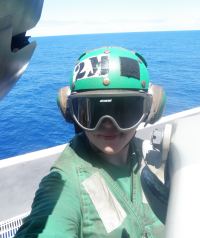

“I remember having to wear everything – rubber gloves, goggles, and we were supposed to be wearing aprons. We were issued masks and canisters, but we never ended up actually using them. They were considered dirty jets because of the radiation. We would take the brakes off and take them over to a special area to be tested because they were dirty. We had cleanup routines we went through and washed everything over and over to the point where you could stop testing and setting off alarms.
“For every panel we took off, we had to turn a part in and take it to someone for testing. If the radiation was higher than allowed, you had to call other people to take care of it. It made the work more difficult.”
There were no manuals on how to keep radiation from spreading through the ship – inevitably, particles clinging to clothes or shoes, or blown in with the air would contaminate interior sections and set off alarms. The sailors, said Micke, improvised:
“The method of keeping radiation out, to keep it from seeping under the doors, was to stuff all the door jams and cracks with rags and there were signs all over the place saying ‘Do Not Remove Rags’. I thought that was pretty interesting.
“I was always scared.”
It was interesting, but ineffective.
Up on the captain’s bridge it became clear that the ship was contaminated. It had snowed and sailors had a snowball fight – till the sensors revealed that the snow itself was contaminated, having scrubbed skies of radioactive particulates. Turning on the high pressure hoses, which take water from the sea, to clean off the decks only made matters worse.
“TEPCO, the nuclear plant operator, was telling our representatives that they weren’t leaking radiation at all. But the entire ship got contaminated. They made the entire crew get chemical, radiological, and biological warfare suits. Then we had to use gas masks in case the air was contaminated.
“We ran out of water for a day and had to cut out showers. They had to pretty much discharge all the water we had in our tanks and scrub out the tanks. They couldn’t do that till we were way out to sea.”
The problem lay in the ship’s water system, which relied on uncontaminated ocean water.
“We make our own water using desalinization plants on board,” explained Plym. “So they had to get rid of all the water throughout the ship and keep testing till it was clean. That was hard. We had been getting water from the ocean and the ocean was contaminated. And on ship, water was in everything. “
Cleaning an aircraft carrier while on maneuvers is not a simple task. “You pretty much have to lock down the ship,” said Enis , “then scrub down anyone who is infected, and scrub down all the tools and everything in each section. Then you go through three checkpoints to make sure there is no radiation in you or on you before you can go to the clean part of the ship.”
And power on the carrier was reduced because the Reagan’s own nuclear power plant needed clean water for its cooling system, which was essential for the actual power generating turbine. Contaminating the “clean” side of the nuclear power plant would make it impossible for sailors to work there.
“They just shut off all the water and drained it till all the contamination was gone from the ship,” said Enis.
–Winifred Bird contributed reporting from Japan
By Roger Witherspoon
The large black sailor was naked in the middle of a roped-off area below decks, and he was none too happy.
“He kept saying ‘Not my boots, too. My wife just bought them for me.’ But they made him take them off anyway, and he was just there, naked. Then they made him scrub,” recalled Maurice Enis, navigator of the USS Ronald Reagan, one of the Navy’s newest aircraft carriers.
“They gave him this really abrasive stuff that we use to clean the hull of the ship. It’s sort of like liquid sandpaper. And he had to scrub all over while everyone watched. Then he walked over to the sink and rinsed it off, then came back and stood while they ran the Geiger counter over him. He had to keep doing it till the Geiger counter was quiet.
“Then it was my turn.”
There was a dark turn to Operation Tomodachi, the massive search and rescue effort launched March 11, 2011, off the northern coast of Japan which had been ravaged by an earthquake and giant tsunami. The combined natural disasters left some 20,000 Japanese dead and the coastal infrastructure destroyed. Tomodachi, the Japanese word for “friend”, was an 80-day mission requested by the Japanese government and coordinated by the US State Department and the Department of Defense. The DoD quickly mobilized its 63 Japanese bases and called in the USS Ronald Reagan, carrying 5,500 sailors and Marines, along with its Strike Group consisting of four destroyers – The Preble, McCampbell, Curtis Wilbur, and McCain – the Cruiser USS Chancellorsville, and several support ships ( http://bit.ly/11bfTqS ).
But the rescue mission quickly detoured down a dangerous, uncharted path. The earthquake had cracked Unit 1 of the Fukushima Daiichi nuclear reactors, and the tsunami had knocked out all power to the safety systems controlling Units 1 through 4. Control of the mission was expanded to include the Nuclear Regulatory Commission and the Department of Energy.
The fuel in Units 1 through 3 was quickly melting down. The fuel in Unit 4 had been offloaded to the spent fuel pool – which was located above the reactor itself – due to a planned refueling. By March 15 explosions had blown the roofs off and the walls out of all four reactor buildings and radiation was spewing into the air.
There was no power to circulate water in any of these buildings, so the Japanese had to improvise. They borrowed high powered pumping trucks from the Americans and poured water onto the buildings, let it run through the spent fuel pool and reactors, and out the bottom, where it flowed into the ocean. All the while, however, the Tokyo Electric Power Company and the Japanese government sought to minimize the radiological disaster. TEPCO would declare there was little or no radiation when, in fact, contamination was high and out of control.
There were some 70,000 American service members and their families in Japan and Defense officials were worried that they might all have to be evacuated. Family members were evacuated from Yokosuka Naval Air Base, 188 miles south of Fukushima, when radiation was detected in increasing amounts there. It was that detection which convinced American officials that the Japanese were not being honest. By calculating the amount of radiation that must have been released in order for Yokosuka to be threatened, NRC officials correctly deduced that despite Japanese assurances, the reactors had been breached.
But the overriding concern was for the Americans in the land based installations – the men and women of Operation Tomodachi were overlooked. And at times, they were just two miles off the coast of Fukushima as helicopters went back and forth, seeking survivors and transporting food and supplies.
The Americans at sea were on their own.
A Growing Fear
For Quartermaster Enis, the wait for decontamination was a completely unexpected turn of events. The quartermasters had two main responsibilities: navigating the ship, and operating the signal flags attached to the mast, which let others in the fleet know what the flagship was doing. Enis had been ordered to bring down the American flag, which had been flying atop the mast for two weeks, and bring it to the Captain’s quarters.
“I brought it down,” he said, “and folded it respectfully and tucked it under my right arm, next to my body. I carried it inside, put it away, and thought nothing of it.”
After dinner, he was walking past a sensor “and the alarms all went off,” he recalled. “And they began yelling at me not to touch anything or anyone and to go straight to the decontamination area.”
There was a line in the cordoned-off “decon” area with men and women waiting to be checked. But Enis didn’t have to wait – he was already marked and was ushered to the front, where a tableau was playing out under the watchful eyes of the Reagan’s executive officer and senior medical officer. The naked sailor in the center of the room was given a towel to cover himself and left. They called Enis.
“They had told us that there was no radiation,” said Enis. “When they started putting up the stations along the ship to check for radiation they didn’t say why they were there. They checked my boots and nothing happened. Then they checked my hands and the machine goes crazy.
“The guy doing the checking freaked out and said to ‘Step away from him!’ Next thing I know, I got plastic bags on my arms and they are telling everyone to get away from me. I almost had an anxiety attack because they were treating me like I had the plague. They weren’t touching me. They were yelling commands to where I had to walk and what I had to do. I had to scrub my hands and my right side with this gritty paint remover and it took off a couple of layers of skin.”
Enis was not told, then or later, exactly what his radiation reading was. They did say his was the highest level recorded among personnel on the ship. At that time, however, the radiation level was not his main concern. Fear of the unknown consumed his attention.
The officers were watching him and barking orders. His fellow sailors – men and women – silently watched him from the edges of the decon station while waiting their turn to be checked for radiation.
“It was pretty embarrassing,” said Enis. “You’re half naked and getting yelled at and scrubbing in front of all sorts of people and I’m scared because they are not telling me what is going on. The way they acted, I thought I must be in real trouble. And it scared the crew. None of us were experts on radiation. You ask yourself are you going to die? Are you going to get cancer? Are you going to be shipped off? I didn’t know if my skin was going to bubble up or something. I didn’t know anything.”
The Navy had been assured that radioactive particles could be washed away with soap and water. That was partly true. Particles emitting alpha rays, the weakest sort, could be washed away from smooth surfaces. Those emitting beta rays, which are stronger, can also be washed away as long as there are no breaks in the skin providing pathways to enter the body. The abrasive paint-removing soap used by the Navy, however, removed the top layers of skin. In addition, the carrier’s flight deck is not made of smooth plastic or glass. Merely scrubbing would not remove particulates from such porous surfaces.
The Reagan’s crew had been assured that there was no radiation to worry about over the open ocean and, as the ship’s navigator, Enis had been led to believe that the radiation was a distinct plume that they could avoid. It was now apparent that the radiation cloud was everywhere, and avoiding it would not always be possible.
On the quarter mile long deck there was another alarming note.
“I had a digital watch,” said quartermaster Jaime Plym, “and it suddenly stopped working. Somebody made a crack that radiation would do that. There were five or six of us on deck and everyone looked at their watches – and all the digital watches had stopped. There was one that was real expensive, and it wasn’t working either.
“We were laughing at first. But then that petered out and we just sort of looked at each other because it wasn’t funny anymore.”
And those who worked below decks had even less information to go on. The jet mechanics, said Jennifer Micke, had most of the aircraft parts brought down to them for testing. There was limited access to the huge hangar elevators.
“They set up a hatch watch,” Micke recalled, “which was people from the air squadrons sitting in folding chairs and making sure no one went on deck through the catwalk. They were to enter and exit only through the front of the ship because they wanted to reduce the level of contamination in the rest of the ship.
“So they would pretty much sit there all day and yell at people who went the wrong way.”
Micke knew the jets on the flight deck were in a radioactive environment. “Every time we came off the flight deck,” she said, “some guy would have to scrub your boots and toss them in a pile and take them away. When you were going up on deck you would put on a pair of boots over your regular boots so they would have to throw those away. Then we had the chemical, biological, radiological suits that we had to put on.
“We were issued masks and canisters, but we never ended up actually using them.”
How well these precautions worked is an open question. An aircraft carrier is a complex industrial town and, at any given time, major and minor pieces of equipment are broken. Some of the damage came from normal wear and tear, and other damage came from accidents.
During Operation Tomodachi, the effectiveness of putting rags under the doors to limit the spread of air-borne radiation was compromised by the fact that there were broken doors, broken door jams and seals and, in some places, water-tight doors which had been removed and taken to the Reagan’s machine shop for repairs. On paper the USS Ronald Reagan was a series of closed compartments. In reality, it was more of a floating catacomb with the air flowing freely through it.
Nothing to Worry About
The official position of the US Navy is that there was very little radioactive contamination of any of its personnel. The Defense Department created the Tomodachi Medical Registry ( http://bit.ly/14ABPuj ) over a two year period, compiling the medical records of some 70,000 military personnel and their families who could have been exposed to varying amounts of radiation during the crisis in Japan.
The Registry was completed in December, 2012. One month later, the Department concluded that their estimates of the maximum possible whole body and thyroid doses of contaminants were not severe enough to warrant further examination. The Registry, the only epidemiologically valid way to determine over time if there is a pattern of illnesses which could be traced to that exposure, was abandoned.
Overlooked, however, is the fact that the Navy’s Registry, as a tool to accurately chronicle medical anomalies among the 70,000 contaminated Americans, was flawed in its inception. The Navy did not conduct a thorough medical examination of each person to establish an accurate baseline of their health. Instead, the Registry is an amalgam of all their latest health records.
In practice, that meant there was no real way to know what the actual baseline health condition was for each individual. Without that baseline, Veterans Administration physicians could not tell if the development of a tumor, or asthma, or cyst inside the body or on the skin represented a radical departure from the patient’s condition at the time of exposure to radiation or if the condition predated Operation Tomodachi. Without that baseline or an active registry showing similar medical issues among many service men and women, there is little chance for veterans to successfully claim that exposure to radiation lay at the root of their health problems.
The decision that the Americans in Japan were probably safe was not unreasonable. Ed Lyman, a nuclear physicist with the Union of Concerned Scientists, who is
writing a book on the meltdowns with nuclear safety engineer Dave Lochbaum and Pulitzer Prize-winning journalist Susan Stranahan, said that both government and independent researchers have tried to calculate the level of contaminants from the reactors at Fukushima Daiichi.
“The consensus was it wasn’t as bad as it could have been,” said Lyman. “It would be hard to see that anyone could have acquired a serious dose in that short a period of time. The dose rates were only high enough, from what’s publicly known, to cause that kind of injury fairly close to the plant grounds to have lasting health effects.
“Still, I am always in favor of collecting data. Five years may not be enough time for radiation –induced cancer to appear in most cases. But more data is always better.”
Others are more skeptical.
 “I had no faith in the Registry to begin with,” said Arnie Gundersen, a nuclear engineer and specialist in the spread of radiation in the environment. “With the atomic bomb survivors from the military program in the Utah desert, the registry that the Defense Department put together was bogus. The exposure they got was much greater than the Defense Department calculated.
“I had no faith in the Registry to begin with,” said Arnie Gundersen, a nuclear engineer and specialist in the spread of radiation in the environment. “With the atomic bomb survivors from the military program in the Utah desert, the registry that the Defense Department put together was bogus. The exposure they got was much greater than the Defense Department calculated.
“Knowing that the Defense Department has a history of putting people into harm’s way and then minimizing the exposure, I had no faith in this latest effort.”
Gundersen said he is “disappointed, but not surprised” that the Tomodachi Registry has been shelved. “It’s pretty clear that those on the Ronald Reagan got higher exposures than their commanding officers are claiming. Too many people had common symptoms that I can’t attribute to mass hysteria.
“One of the big uncalculated numbers are from the noble gasses. These blew over the carrier and they didn’t stick, but they are inhaled by personnel when you see the guys swabbing the decks to clear out particulates. That was a bad sign. You are not supposed to get particulates 100 miles offshore. So what the hell did the sailors breathe in? Their lungs have to have the same crap that was on the deck and in the water, and none of the Defense Departments exposure assessments take into account the hot particles in the sailors’ lungs.” ( https://www.youtube.com/watch?v=HCzuPm4T4qo )
And those who participated in Operation Tomodachi know that there are problems.
Collateral Damage
“My health started going south at the beginning of last year,” said Micke, the F-18 structural mechanic and hazmat coordinator on the USS Reagan. “On March 30, I was standing in formation during the change of command in California, and I passed out for the first time.
“They told me I was just dehydrated, so I sat there in the medic area and drank a bottle of water. Then, on April 29, I passed out once more and this time they took me to the emergency room and I told them I had a headache.
“They said ‘Maybe you hit your head’. So they did a cat scan and came back and said ‘We found this mass in your brain’. I’ve had two surgeries since then and I’m out of the Navy.”
Technically, what the doctors found was a level 2, Oligoastrocytoma cancer ( http://en.wikipedia.org/wiki/Oligoastrocytoma ) in Micke’s frontal lobe. It is a pernicious, incurable cancer which lodges in the area of the brain responsible for coherent speech. Removing the bulk of the growth leaves a cavity which, in some cases, can collapse and cause collateral damage.
After Micke’s second surgery last fall she was informed that “it’s not active right now. The parts they left up there are just sitting there, dormant. I know they are up there, and it’s not as bad as it could be since they aren’t doing anything and it doesn’t hurt.
“I go back to the hospital every two months to have it checked. It’s pretty stressful, but it’s definitely livable.”
Living means she is back where it all began, on her parents’ farm in Thorp, Wisconsin, waiting for the next eruption of her cancer. “At this point,” said Micke, “I have so many doctors’ appointments that it is difficult to really do anything as far as getting a job 5 days a week. I don’t have a car so my parents are driving me everywhere.”
Micke has reconciled herself to living with the unpredictable. “My future plans haven’t changed severely,” she said. “I still plan on going to college, getting a good job, and continuing life. As for the cancer, it’s a part of me, like living with your hand. You come to terms with it and live with it.
“You live for today and be yourself and enjoy life for as long as you can.”
She is part of the group suing TEPCO for misleading the American government about the conditions of its reactors and the true release of radiation, which she blames for her condition.
“I’m just mainly doing it so it doesn’t happen to anybody else, just so somebody is held accountable,” she explained. “Hiding stuff messes with people’s lives in the long run, and I don’t want to see this happen to anybody else.
“As for the Navy, I don’t see where they could have done much more. It’s not something you train for. They did the best they could with the information they had. And I have great memories of the people I worked with, and the places I’ve been.”
To some degree, Micke is fortunate that she passed out and was diagnosed while still in the Navy. At the moment, her medical expenses are being covered. But that may change.
“The doctors have not determined yet if it is service connected,” Micke said.
Since the Defense Department has pre-determined that radiation did not cause any illnesses among its personnel and has cancelled the Tomodachi Medical Registry – which is the only epidemiological way to determine patterns of health problems – Micke may yet become a Navy veteran with an incurable cancer and no health care.
Ageing Fast
“You couldn’t put the radiator back in,” said Sebourn. “It had to be replaced. We dumped it into a barrel full of water and soap and set the barrel behind a barrier, like a police line. Then every day we would take measurements to see if any of the radiation was seeping through.
“The barrels gave off radiation, and it takes years and years for the radioactive material to decay on its own. We would take off our Tyvek suits and cut them off and put them into the barrels, too. Everything that had seals or were dirty had to go into the barrels, since that’s what the radiation sticks to. The more we put into the barrels, the more the radiation grew. It seemed to feed on itself.”
That was a hectic 80-day period in the spring of 2011 which Sebourn thought was behind him forever. He was wrong. His eight-year-old son, Kai, got mysteriously ill in May, 2011.
“He went through vomiting fits and missed three weeks of school,” said Sebourn. “They had a rule then that if you threw up you were sent home, and he would throw up 10 – 15 times a day. He didn’t feel bad, but he couldn’t stop vomiting.
“Eventually they just wrote it off as stress. He still has those episodes and they never have been able to evaluate why he does it.”
But Sebourn was fine, until last year.
“In March of 2012 I got some medical problems which the Navy doctors couldn’t explain,” he said. “The right side of my body is at 40% to 50% of its normal strength. I’ve had two MRIs, had X-rays, ultrasound, and they can’t figure out what is wrong with me.
“My arm, chest and shoulder are sore and I’m getting disproportionately big on my left side, which is odd since I’m right handed and use that side more.”
Neither he nor Kai received genetic counseling or monitoring. After 17 years of service the Navy covers only Sebourn’s health care for five years, “and after that I’m on my own. Once you get out of the military you are still covered for a little while, but your family members are not.”
And after those five years are over? “That’s a wonderful question,” said Sebourn, who continues to get weaker on his right side, as if that part of his body is ageing prematurely.
“I understand that the Tomodachi Registry for the 70,000 servicemen and family members was supposed to help with that, and if we came down with health problems 10 or 15 years down the road we would be eligible for health care since it is related to our service.
“But at the last moment DoD scrapped the program, so I don’t know what will happen to us.”
Part of his reason for joining the suit against TEPCO was to ensure that the nuclear power company took responsibility for the damage it caused, and covered future health care needs.
“I’m not upset with the Navy about the radiation – they had no idea what was going on because we had never dealt with this. The navy never lied to us. The navy did the best they could. We were all flying blind.”
Navigating the Bureaucracy
As the USS Ronald Reagan and its attendant Strike Force 7 sped away from Japan at the conclusion of Operation Tomodachi, navigators Plym and Enis felt a sense of relief. It was over and they were told by radiation inspection teams that they were safe.
“They didn’t test us for any internal contamination or anything,” said Plym. “They just ran a machine over our skin. They never did any blood tests or any other type of tests.”
“We were out there for 80 days,” said Enis, “and towards the end I realized I had a small lump on my lower jaw. I went to see if I could get it checked out, but by then the radiation expert had been flown off the ship.
“After that, I started getting bad stomach ulcers and two more lumps appeared – one on my lower thigh, and one between my eyes.”
The Reagan headed for Peugeot Sound for a year of decontamination and general overhaul. Enis, who had enlisted for just four years, enrolled in Olympic College in
Bremerton, Washington, to productively pass the time while waiting for Plym, who had signed up for a five year tour.
“One of the big things you say in the navy,” Enis recalled, “is when I get out I’m gonna let my hair grow, and have a big beard. That’s because while you’re in the Navy you have to have that skin-tight face and hair.
“Well I grew out my hair and had a goatee, and then my hair started falling out. I rarely comb my hair now because if I do, gobs of it come out on the comb. And I find my right hand shakes when I’m writing.”
Enis, a strapping six-foot two –inch athlete was MVP of Olympic’s college football team, and his time in the 400-meter dash was within two seconds of the 2012 Olympic qualifying time. Now, he has trouble finding the energy to make it through the day.
“I’m only 25,” he said, “and my body is breaking down. I shouldn’t be hurting like I’m hurting now. I went out of my way to take care of my body, and now it’s like switches are being turned off inside me. It makes me feel like an old man, and I don’t like it.
“I don’t know what radiation may have done. But I know I didn’t bring this upon myself.”
He has been informed by the Navy that they “lost” his medical records and, there is no way to trace his current problems to his service on the USS Ronald Reagan. His medical needs, therefore, will not be covered.
For Plym, the problems at first seemed to be a nuisance. “My menstrual cycle completely went away for the six months,” she said. “They gave me a hundred million
pregnancy tests because they couldn’t figure out why it stopped. But I wasn’t pregnant.
“Then, six months later, it came back so heavily I went to the emergency room because I was hemorrhaging and losing so much blood I was fainting.”
It is, she said, a recurring phenomenon with no apparent medical explanation. A normal menstrual period suddenly morphs into rapid, uncontrolled bleeding requiring medical intervention in a hospital. In March, 2012 she developed asthma and had the first of six bouts of bronchitis before she left the Navy in December.
The Navy does not consider gynecological problems to be service related. The possibility that inhaling radioactive particles might affect Plym’s lung problems was ruled out when the Defense Department decided that there were no health problems caused by participation in Operation Tomodachi. So she, too, has no health insurance.
The former navigators have settled in Jacksonville, Florida and are attending St. Johns River State College with the hope of transferring to the University of North Florida. Both have fond memories of their Navy years.
“Part of me wants to believe that the Navy wouldn’t deliberately do something to hurt the crew,” she said. “I remember the few bits of news we got during that period, and the Japanese said there was no danger from the power plant, the radiation didn’t leak out and they had it all under control.
“The Japanese lied, and I put the blame on them.”
Enis, however, is a torn. “The Japanese lied to our government,” he said. “And a part of me wants to think that the Navy wouldn’t do that to the crew, that they wouldn’t put us in a dangerous situation like that on purpose.
“But then, there’s a part of me that says they just did.”
–Winifred Bird contributed reporting from Japan
–Roger Witherspoon writes Energy Matters at www.RogerWitherspoon.com
A Lasting Legacy of the Fukushima Rescue Mission;
Part 1: Radioactive Contamination of American Sailors
Part 2: The Navy Life — Into the Abyss
Part 3: Cat and Mouse with a Nuclear Ghost
Related Posts:
Japan’s Throwaway People and the Fallout from Fukushima
White House Moves Swiftly to Replace NRC’s Jaczko
